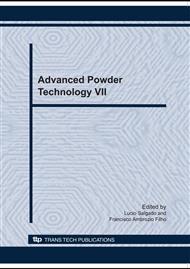p.468
p.477
p.483
p.489
p.495
p.503
p.515
p.520
p.525
Sintering of a SiC-Diamond Composite with a New Setup for the Reactive Cell
Abstract:
Polycrystalline SiC-diamond composites have been fabricated by high pressure and high temperature, HPHT, sintering conditions using a Si infiltration method. However, infiltration of liquid Si around the diamond particles results not only in SiC but also in free Si, which causes deterioration of the composite properties. In this work, a novel sintering procedure was developed to avoid the formation of free Si in the composite structure. A disk composed of a mixture of graphite and Si was first press-molded at room temperature. The disk was then placed above the diamond powder inside a high pressure chamber used for the HPHT sintering process. This arrangement permitted to preferentially form liquid SiC, which infiltrates in between the diamond particles. Using this procedure, free Si formation is inhibited and the SiC-diamond composite forms a rigid structure with improved properties.
Info:
Periodical:
Pages:
495-500
Citation:
Online since:
October 2010
Keywords:
Price:
Сopyright:
© 2010 Trans Tech Publications Ltd. All Rights Reserved
Share:
Citation:


